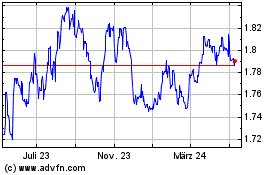Euro Falls As ECB Warns On Downside Risks To Euro Area; Hints At Addl. Stimulus
05 Mai 2016 - 9:19AM
RTTF2
The euro declined against its major counterparts in European
trading on Thursday, after the European Central Bank warned over
downside risks to the economy and reiterated that it is ready to
use all available instruments to stimulate growth in the bloc.
In its economic bulletin, the ECB said that the economic
recovery in the euro area is still dampened by the ongoing balance
sheet adjustments in a number of sectors, the insufficient pace of
implementation of structural reforms in some countries and subdued
growth prospects in emerging markets. The risks to the euro area
growth outlook remain tilted to the downside.
Owing to lower energy prices, inflation rates are expected to be
negative in the coming months, although it would pick up during the
second half of 2016.
The bank acknowledged that it is vital to preserve an
appropriate degree of monetary accommodation to underpin the
momentum of the euro area's economic recovery and reach
inflationary target of below, but close to, 2 percent.
"The Governing Council will continue to monitor closely the
evolution of the outlook for price stability and, if warranted to
achieve its objective, will act by using all the instruments
available within its mandate," it added.
European stocks rose as oil prices rallied and a rally in bond
markets fizzled out ahead of the April U.S. jobs report, set for
release on Friday.
That said, the gains were tempered by lackluster data out of
China and the U.K. and the Ascension Day holiday in parts of
Europe.
The currency showed mixed trading in Asian deals. While the euro
fell against the pound, it held steady against the franc, greenback
and the yen.
Reversing from an early high of 1.5410 against the aussie, the
euro declined to a 2-day low of 1.5276. The euro is seen finding
support around the 1.52 zone.
The euro edged down to 1.6598 against the kiwi and 1.4662
against the loonie, off its early highs of 1.6713 and
1.4786,respectively. The next possible support levels for the euro
may be found around 1.65 against the kiwi and 1.45 against the
loonie.
The euro declined to a 6-day low of 1.1426 against the
greenback, after having advanced to 1.1494 at 9:30 pm ET.
Continuation of the euro's downtrend may see it finding support
around the 1.12 mark.
The 19-nation currency edged down to 122.56 against the Japanese
yen, following an advance to 123.13 at 8:45 pm ET. If the euro-yen
pair extends slide, it may challenge support near the 120.00
level.
The single currency slipped to a 2-day low of 0.7883 against the
pound, off its prior high of 0.7925. On the downside, the euro may
test support around the 0.76 area.
Survey data from Markit showed that the U.K. service sector
activity expanded at the slowest pace in more than three years in
April.
The Chartered Institute of Procurement & Supply/Markit
services Purchasing Managers' Index fell to 52.3 in April from 53.7
in March.
On the flip side, the euro continued to be higher against the
franc, reaching near a 2-month high of 1.1018. The euro may locate
resistance around the 1.12 level.
Looking ahead, Canada building permits for March and U.S. weekly
jobless claims for the week ended April 30 are slated for release
in the New York session.
At 9:15 am ET, ECB Vice President Vitor Constancio speaks on
"Re-Inventing the Role of Central Banks in Financial Stability", in
Ottawa.
At 11:50 am ET, Federal Reserve Bank of St. Louis President
James Bullard is expected to speak on the U.S. economy and monetary
policy, and is a part of a panel at the 35th Santa Barbara County
Summit in Santa Barbara.
Euro vs NZD (FX:EURNZD)
Forex Chart
Von Mär 2024 bis Apr 2024

Euro vs NZD (FX:EURNZD)
Forex Chart
Von Apr 2023 bis Apr 2024
